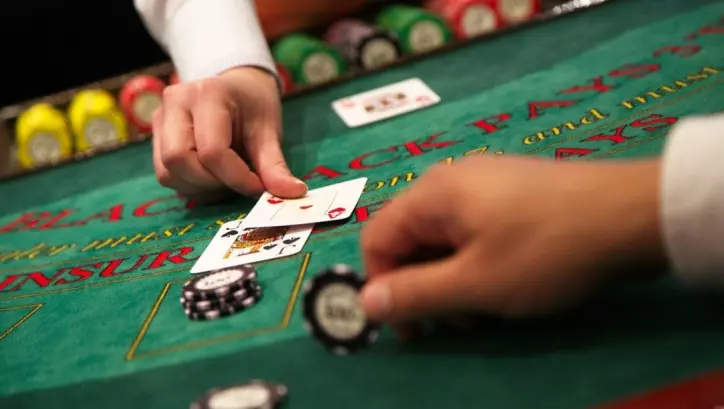Looking to craft a successful blackjack strategy for single-deck games? You’re not alone. Single-deck blackjack, also known as single-hand blackjack, represents a variation of the classic casino game, played with just one deck of cards. The significance lies in the fact that the fewer the decks, the greater your chances of winning.
Continue reading to delve into the distinctions between single- and double-deck blackjack and discover how to maximize your advantage in single-deck blackjack, whether playing in-person or online.
How Single-Deck Differs from Double-Deck Blackjack
The primary distinction between single-deck and double-deck blackjack revolves around the number of decks used in the game. As the names imply, single-deck blackjack utilizes one deck of 52 cards, while double-deck blackjack employs two decks, totaling 104 cards. Despite its apparent smallness, this difference results in several significant variations in gameplay and the strategies players should employ:
Card-Counting Complexity
Card counting, a widely employed and potentially lucrative strategy in blackjack, is unsurprisingly easier in a single-deck game due to the smaller number of cards to track (although more frequent shuffling can pose challenges for some card counters – more on that below). Conversely, double-deck blackjack introduces increased complexity to card counting due to the higher number of cards.
House Edge

The number of decks used in blackjack significantly influences the house edge. In general, a lower number of decks corresponds to a reduced house edge. Consequently, single-deck blackjack typically boasts a slightly diminished house edge compared to double-deck blackjack, assuming similar rules are in place.
Frequency of Shuffling
Single-deck blackjack involves more frequent shuffling due to the smaller card pool. This increased shuffling can disrupt card-counting strategies. Conversely, double-deck games feature less frequent shuffling, allowing for more gameplay before reshuffling occurs.
Variations in Gameplay
Rules and playing strategies can differ between single and double-deck games. Variations may include differences in how the dealer handles a soft 17, as well as distinct options for splitting and doubling down.
Betting Strategies
With a greater number of cards in play in double-deck blackjack, fluctuations in odds tend to be less abrupt compared to single-deck games. This discrepancy can influence betting strategies, as the probability of specific outcomes changes differently with each dealt card.
Differences in Payouts
Certain casinos may adjust payouts in single-deck games to maintain their house edge, opting for a 6:5 payout for blackjack instead of the standard 3:2. This practice is less common in double-deck games.
Card Counting: A Game-Changing Tactic
Card counting is a widely used technique that can provide an edge in blackjack and is often a key element in many gamblers’ strategies for single-deck blackjack. The fundamental approach involves tracking the dealt high and low cards:
1.Assign Values: High cards (10s and aces) are -1, low cards (2-6) are +1, and the rest are 0.
2.Maintain a Running Count: Add or subtract card values from your running count as cards are dealt.
3.Adjust Your Bets: Increase bets when the count is high (indicating more high cards in the deck) and decrease them when the count is low.
It’s important to note that while card counting is not illegal, casinos generally frown upon it. If they suspect a player is counting cards, they may ask them to leave.

Consider these pointers when engaging in a game of single-deck blackjack:
1.Grasp Basic Strategy: Familiarize yourself with guidelines dictating when to hit, stand, split, or double down based on your hand and the dealer’s upcard. Adhere to this strategy consistently.
2.Steer Clear of Insurance Bets: Generally, these bets aren’t advisable as they elevate the house’s advantage.
3.Monitor Payouts: Ensure you play at a table offering 3:2 payouts for blackjack, not the less favorable 6:5.
4.Maintain Discipline: Resist the urge to chase losses and keep your emotions in check.
5.Comprehend Deck Penetration: Understand the percentage of cards dealt before reshuffling, as higher deck penetration benefits card counters by providing a more accurate gauge of remaining cards.
6.Hone Card Counting Techniques: Practice card counting, especially with simpler systems like the hi-lo system, which proves effective in a single-deck game. Begin practicing at home using a single deck.
7.Manage Your Bankroll: Set betting limits in advance and adhere to them. Wager only a small percentage of your bankroll per hand to minimize the risk of rapid losses.
8.Emotional Control: Keep a level head and don’t let wins or losses influence your strategy. If frustration sets in, take a break to avoid making poor decisions.
9.Practice Both Online and Offline: Utilize single-deck blackjack online simulators to refine your skills. Many websites offer free single-deck blackjack games. Additionally, practice with friends or alone by dealing cards to yourself to master basic strategy and card counting.
In summary, single-deck blackjack presents a distinctive opportunity to reduce the house edge and employ techniques like card counting effectively. Through a solid understanding of rules, mastery of basic strategy, and regular practice, you can enhance your likelihood of outplaying the house. Remember, success in the game requires skill, discipline, and a touch of luck. Enjoy the experience!


